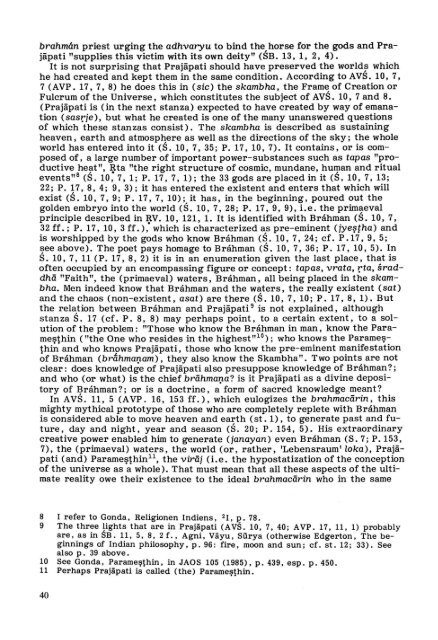Prajapati's relations with Brahman, Brhaspati and Brahma - DWC
Prajapati's relations with Brahman, Brhaspati and Brahma - DWC
Prajapati's relations with Brahman, Brhaspati and Brahma - DWC
Create successful ePaper yourself
Turn your PDF publications into a flip-book with our unique Google optimized e-Paper software.
ahmán priest urging the adhvaryu to bind the horse for the gods <strong>and</strong> Prajäpati<br />
"supplies this victim <strong>with</strong> its own deity" OSB. 13, 1, 2, 4).<br />
It is not surprising that Prajäpati should have preserved the worlds which<br />
he had created <strong>and</strong> kept them in the same condition . According to AVS. 10, 7,<br />
7 (AVP. 17, 7,8) he does this in (sic) the skambha, the Frame of Creation or<br />
Fulcrum of the Universe , which constitutes the subject of AV8. 10, 7 <strong>and</strong> 8.<br />
(Prajäpati is (in the next stanza) expected to have created by way of emanation<br />
(sasrje), but what he created is one of the many unanswered questions<br />
of which these stanzas consist ). The skambha is described as sustaining<br />
heaven, earth <strong>and</strong> atmosphere as weIl as the directions of the sky; the whole<br />
world has entered into it (8. 10, 7, 35; P. 17, 10, 7). It contains, or is composed<br />
of, a large number of important power-sub stances such as tapas "productive<br />
heat", Rta "the right structure of cosmic, mundane, human <strong>and</strong> ritual<br />
events"S (8.10; 7,1; P. 17, 7, 1); the 33 gods are placed in it (8. 10, 7,13;<br />
22; P. 17, 8, 4; 9, 3); it has entered the existent <strong>and</strong> enters that which will<br />
exist (8. 10, 7, 9; P. 17, 7, 10); it has, in the beginning , poured out the<br />
golden embryo into the world (8. 10, 7, 28; P. 17, 9, 9), i. e. the primaeval<br />
principle described in RV. 10, 121, 1. It is identified <strong>with</strong> Bráhman (8. 10, 7,<br />
32 ff.; P. 17, 10, 3 ff.): which is characterized ~s pre-eminent (jye~tha) <strong>and</strong><br />
is worshipped by the gods who know Bráhman (8. 10, 7, 24; cf. P. 17, 9, 5;<br />
~ee above). The poet pays homage to Bráhman (8.10,7,36; P. 17, 10,5). In<br />
8. 10, 7, 11 (P. 17, 8, 2) it is in an enumeration given the last place, that is<br />
of ten occupied by an encompassing figure or concept: tapas, vrata, rta, sraddhä<br />
"Faith", the (primaeval) waters, Bráhman, all being placed in the skambha.<br />
Men indeed know that Bráhman <strong>and</strong> the waters, the really existent (sat)<br />
<strong>and</strong> the chaos (non-existent, asat) are there (8. 10, 7, 10; P. 17, 8,1). But<br />
the rela,tion bet ween Bráhman <strong>and</strong> Prajäpati 9 is not explained, although<br />
stanza 8. 17 (cf. P. 8, 8) may perhaps point, to a certain extent, to a solution<br />
of theproblem: "Those who know the Bráhman in man, know the Parame~thin<br />
("the One who resides in the highest"lO); who knows the Parame~thin<br />
<strong>and</strong> who knows Prajäpati, those who know the pre-eminent manifestation<br />
of Bráhman (bráhmm;wm) , they also know the 8kambha". Two points are not<br />
clear: does knowledge of Prajäpati also presuppose knowledge of Bráhman?;<br />
<strong>and</strong> who (or what) is the chief brähmar;ta? is it Prajäpati as a divine depository<br />
of Bráhman?; or is a doctrine, a form of sacred knowledge meant?<br />
In AV8. 11,5 (AVP. 16, 153 ff.), which eulogizes the brahmacärin, this<br />
mighty mythical prototype of those who are completely replete <strong>with</strong> Bráhman<br />
is considered able to move heaven <strong>and</strong> earth (st. 1), to generate past <strong>and</strong> future,<br />
day <strong>and</strong> night, year <strong>and</strong> season (8. 20; P. 154,5). His extraordinary<br />
creative power enabled him to generate (janayan) even Bráhman (8.7; P. 153,<br />
7), the (primaeval) waters, the world (or, rather, 'Lebensraum' loka), Prajäpati<br />
(<strong>and</strong>) Parame~thinll, the viräj (i.e. the hypostatization of the conception<br />
of the universe as a whoie). That must mean that all these aspects of the ultimate<br />
reality owe their existence to the ideal brahmacärin who in the same<br />
8 I refer to Gonda, Religionen Indiens. 2 I. p. 78.<br />
9 The thr~e !ights that are in Prajäpati (AVS. 10, 7,40; AVP. 17, 11, 1) probably<br />
are, as In SB. 11, 5, 8. 2 f., Agni, Väyu, Surya (otherwise Edgerton, The beginnings<br />
of Indian philosophy, p. 96: fire, moon <strong>and</strong> sun; cf. st. 12; 33). See<br />
also p. 39 above.<br />
10 See Gonda, Parame!?thin, in JAOS 105 (1985), p. 439, esp. p. 450.<br />
11 Perhaps Prajäpati is called (the) Parame!?thin.<br />
40
















